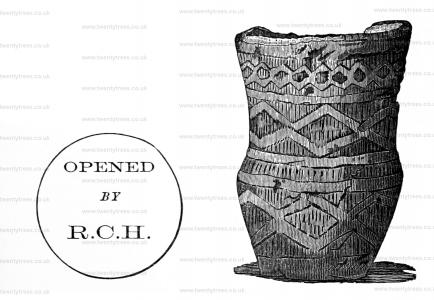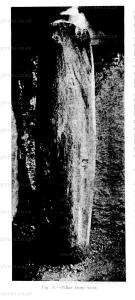Biography of Reverend John Skinner 1772-1839
Reverend John Skinner 1772-1839 is in Antiquaries.
In 1772 Reverend John Skinner was born.
Archaeologia Cambrensis 1908 Supplement. Dec 1802. Archaeolgia Cambrensis 1908 Supplement. Ten Day's Tour Through the Isle of Anglesey in December 1802 by the Reverend John Skinner (age 30), Rector of Camerton, Somersetshire.
In 1839 Reverend John Skinner (age 67) died.
Wiltshire Archaeological Magazine 1859 V6 Pages 317-336. A small low barrow on Pound Down, within a short distance of the last group and nearly opposite the fifth mile-stone from Devizes, was also examined. This proved to be the one opened by Sir R. C. Hoare August 11th, 18141, which was the subject of a lengthy poem, entitled "Beth Pennard, or the British Chieftain's Grave,"2 by the Rev. John Skinner, who with Dean Merewether3, was present at the opening. From the terms in which Sir Richard Hoare describes the situation of this barrow (in which the richly ornamented earthen drinking cup, here figured4, was found near the head of a skeleton) it was at first by no means clear to which he refers. Its identity with that which we re-opened was however proved by the discovery of a brass medal, inscribed OPENED by R.C.H. with the fragments of a skeleton in a cist, which had been excavated to some depth in the chalk. Much poetical merit cannot be claimed for Mr. Skinner's unpublished verses; from which, however, as referring to the opening of this particular barrow, and as containing a complimentary allusion to Sir Richard Hoare, the following lines may be quoted.
Note. Poem Inserted Here.
Note 1. Ancient Wilts, vol. ii. p. 92, No. 4.
Note 2. Wilts Arehæological and Natural History Magazine, vol. iv. p. 361, note.
Note 3. Proceedings Archæologieal Institute, at Salisbury," 1849, p. 109. The Dean's description of the locality is also ambiguous; but one of Sir Richard's pioneers," the octogenarian John Parker, perfectly remembers the barrow as the one we re-opened. Dr. Stukeley says Sir R. C. Hoare, "has recorded the merits of Reuben Horsall, the Town Clerk of Abury: and why should I not do equal justice to those of our Heytesbury pioneers John Parker and his father Stephen, to the former of whom we feel much indebted for many interesting discoveries". Ancient Wilts, vol. i. p. 97.
Note 4. For the use of the wood-cut of this cup, from the Catalogue of the Museum at Stourhead, we are indebted to Messrs. Nichols and Sons, of Parliament Street. The vase is here represented of about one-third its actual size.

The Pillar Stone. The first part of the structure to be examined was the pillar within the chamber (Fig. 3), which was semi-prostrate and resting against stone No. 6. It undoubtedly still occupied the position it had assumed when it was "overturned" at the violation of the monument in the eighteenth century, in spite of a definite statement that it was prostrate in 1847, supported by a drawing made in by the Rev. John Skinner, which shows it lying east and west beside the hole in which it once had stood. The packing blocks placed with extreme care around its base were still in position, with the exception of one or more which had been withdrawn from the south-east side, and so allowed it to incline in that direction. The stone was set upright again, and the blocks had preserved the shape of the socket so accurately that the position it now occupies is precisely that in which it was first placed. The pillar is 8 ft. 3 in. long, and now projects 5 ft. 6 in. above the floor level. Except where it has suffered damage the whole of its surface is smoothed and rounded, and it is slightly flattened on the north-east and north-west sides opposite to stones 7 and 5. The upper 1 ft. 9 in. of the south-west side has been split off and lost, thus depriving the pillar of its symmetry. It is tapered at both ends, the maximum circumference being 4 ft. 7 in. at 4 ft. 3 in. below the top of the stone.

Archaeologia Cambrensis 1908 Supplement Introduction. The Rev. John Skinner's Ten Days' Tour Through Anglesey, which is given in the following pages, has been carefully transcribed from the manuscript in the British Museum, the punctuation, spelling, and use of capitals followed strictly throughout. Some notes have been kindly furnished by Mr. E. Neil Baynes, F.S.A., and he has also copied (in black and white) most of the water-colour illustrations which are included m the manuscript. The illustrations are reduced from the original size, but with this exception and the absence of colour they have been copied as closely as possible, with all errors of perspective, etc. Some of the drawings would appear to have been done by Mr. Skinner in the evening from memory, and not on the spot. The complete list is printed herewith, and the pages where the plates appear in the original. A copy of an extract from Mr. Skinner's will is subjoined, in which he expresses his particular wish that the chests containing his numerous notebooks should not be opened until the expiration of fifty years from the day of his death.
Extracted from the Principal Registry of the Probate Divorce and Admiralty Division of the High Court of Juetiee In the Prerogative Court of Canterbury.
In the will of the Reverend John Skinner late Rector of Camerton in the county of Oxfordshire.
No. 2. I give and bequeath to the trustees of the British Museum all my Journals and other Manuscripts transcribed by my late brother Russell from No. 1 to No. 110 both inclusive and interleaved with original drawings together with the Journals I have made in my own hand-writing since my brother's death from the year one thousand eicrht hundred and thirty three to the year one thousand eight hundred and thirty-eight in volume 1 to volume 36 of an Octavo size with blue Morocco backs containing altogether in number one hundred and forty six which I desire may be safely conveyed to the trustees of the British Museum with the five Iron Chests in which they are now contained and I request tuy said executor the Reverend John Hammond to see to the per- formance of this bequest in the tnanner aforesaid and it is my particular wish and request that neither of the Iron Chests with the contents aforesaid shall be opened till after the expiration of fifty years from the day of my death but provided the trustees of the British Museum should raise any objection thereto it is my will that tny before mentioned request should not be insisted upon.
Proved (with two Codicils)
14th November 1839
Fos 4
J J C
716 Vaughan
N.B.—It is not to be inferred that the foregoing extract contains the only portion of the said Will referring to the matters therein mentioned.
Archaeological Journal Volume 15 Pages 199-215. Stukeley, fresh from the Downs of Wiltshire, wondered that he observed no tumuli or barrows, the burying-places of the people about it, as in other cases, but supposed this owing to the goodness of the soil; for, as he goes on to say, " they wisely pitched upon barren ground to repose their ashes, where they could only hope to lie undisturbed: and on Mendip Hills, not far off, they are very numerous. This particularly I am told of seven that are remarkable." The group to which Stukeley alludes is most probably one of two on Priddy Hill, of which one is formed of nine [Priddy Nine Barrows], and the other of seven barrows [Ashen Hill Barrows]. Many others, however, are to be seen on the Mendip range. The Priddy barrows were examined by the late Rev. John Skinner, in 1815, and in all cases in which the interment was found, cremation appears to have prevailed. In some the ashes were found in urns, in others without urns in cists, or on flat stones without cists. The urns were rude and unbaked, with the zigzag ornament, and usually reversed. One of them was embossed with projecting knobs, like that which was dis interred by Sir R. C. Hoare from a tumulus on Beckhampton Down. The following articles were also discovered: amber beads and a small blue opaque glass bead with them, perforated; brazen (bronze) spear heads; flint and brazen (bronze) arrow-heads; and an ivory pin, upwards of 4 inches long. These barrows are of different sizes, the highest being 12 feet high, and 164 in circumference. The Men clip Mines were doubtless extensively worked by our British forefathers, and a considerable trade in metals must have been carried on by them with foreign nations.
Nempnet aka Fairy Toot Burial Mound [Map] is a 60 m long, 25 m wide and now 2.5 m high, retained by a stone wall, Severn-Cotswold Oval Barrow. On being opened and essentially destroyed between 1787 and 1835 by the Reverend Thomas Bere of Butcombe and the Reverend John Skinner of Camerton, it was found to contain two rows of cells, running from south to north, formed by immense stones set edgeways, and covered by others of larger dimensions. A human skull from the barrow is now in the Bristol Museum and Art Gallery.